Espoo Museum of Modern Art
In Search of the Present Mobile Guide

This mobile guide includes brief videos of artists’ interviews and pictures of each of the 22 works in the exhibition. To select subtitles, please click the cc button in the video player’s toolbar.
The exhibition explores the complex interactions between art, technology and nature. Its title, In Search of the Present, refers to an eponymous collection of essays (1929) by the Finnish author Olavi Paavolainen that examines the experiences and identities of modern people in a rapidly changing era. EMMA’s In Search of the Present is a series of exhibitions, the first of which took place in 2016.
Technology is sometimes seen as the opposite of nature and artificial intelligence as a threat to humanity. For the artists of this exhibition, however, technology is foremost an opportunity. Some of them collaborate with artificial intelligence to create an entirely new kind of art while others examine the need to develop systems that make artificial intelligence more equal, transparent and accessible.
The artists are interested in a new kind of coexistence between humans and nature that is not based on nature’s useful value. They look for new approaches to the major challenges we face today, such as the loss of biodiversity. Technology is used in the works of the exhibition to visualise things that can help us grasp the diversity of nature. Many of the artists draw our attention not only to artificial intelligence and its potential but also to other intelligences found in nature.
A key motif in many of the works is the impact of a reality permeated with technologies that shapes our identities and our view of humanity. Perhaps with the help of technology, we can achieve something that will help us understand ourselves but also make our relationship with nature more diverse. What kind of art do humans and artificial intelligence create together?
Some of the works in the exhibition belong to the collection of the Saastamoinen Foundation or the EMMA collection. New works have also been created for the exhibition.
Artists in the exhibition: Refik Anadol, Dora Budor, Sougwen Chung, Heather Dewey-Hagborg, Stephanie Dinkins, Agnieszka Kurant, Teemu Lehmusruusu, Brandon Lipchik, Rafael Lozano-Hemmer, Sondra Perry, Jaakko Pietiläinen, Anna Ridler, Raimo Saarinen, Jakob Kudsk Steensen, Jenna Sutela and Lu Yang.
Some of the works in the exhibition belong to the Saastamoinen Foundation Art Collection or the EMMA Collection. New works have also been created for the exhibition.
You can find more information about the Water Sprites VR experience here.
The key terminology related to the exhibition are explained here.
The exhibition is curated by Arja Miller and Ingrid Orman.
Project management: Milja Liimatainen
Graphic design: Milla Rissanen
A warm thank-you to the exhibition’s partners: Saastamoinen Foundation, Adam Mickiewicz Institute, Embassy of the Republic of Poland, Embassy of Denmark in Finland.
An Introduction from the Curators

The curators of the In Search of the Present exhibition Arja Miller (on the right) and Ingrid Orman.
1. and 3. Jaakko Pietiläinen
1. I Love New

A figure dressed in a thick coat keeps drawing a circle onto a wall with its glove as long as it has the strength or until the glove wears out. Jaakko Pietiläinen’s (b. 1986) mechanical work seems at once both human and artificial. The figure strokes the museum’s bright white wall, gradually producing a trace, an impression, a sign of life. The work rewards the viewer who constantly yearns for something new by endlessly drawing a hypnotic circle in front of the viewer’s eyes, here and now.
Pietiläinen’s works are often made for a specific location or relate to a specific situation. They exist at the exciting juncture between reality and fantasy.
Technology, body, entertainment
Glove, down jacket, aluminium, steel, plastic, electric motor
Saastamoinen Foundation Art Collection
3. Shrouds have no pockets

Pietiläinen’s (b. 1986) video work is the story of N.N., who is on holiday in luxury hotel. In exchange for first-class service, N.N. must make a daily virtual trip with the iGum device operated with a smartphone application. The device has access to the consciousness of the person using it through a dental nerve.
The work deals with perception, memories and corporality. It moves at the interface between utopia and dystopia and examines broader themes of the addictiveness of technologies and associated compulsions and also control in the entertainment society.
We recommend that you watch the entire work.
Technology, entertainment, experience, body, memory, consciousness, entertainment society
HD video
Duration 29:40 min
Saastamoinen Foundation Art Collection
Artist Interview
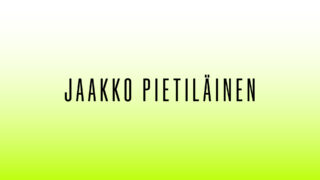
2. Jenna Sutela
nimiia cétiï

Jenna Sutela (born 1983) investigates biological and algorithmic processes through art. In her work, Sutela’ aims to give form and voice to things not otherwise present in the sphere of human awareness. nimiia cétiï is an audiovisual piece where a new written and spoken language has been created with the help of machine learning. The work experiments with what communication between different species could sound like.
This new language is based on a computer interpretation of the Martian language channeled in the 19th century by the spirit medium Hélène Smith and the movements of Bacillus subtilis bacteria. According to recent space research, this bacterium could survive even on Mars. In nimiia cétiï the computer is like a modern-day shaman who conveys knowledge from beyond consciousness.
Machine learning, bacteria, inter-species communications, consciousness
HD-video
Duration 12:00 min
Saastamoinen Foundation Art Collection
4. Dora Budor
The Preserving Machine
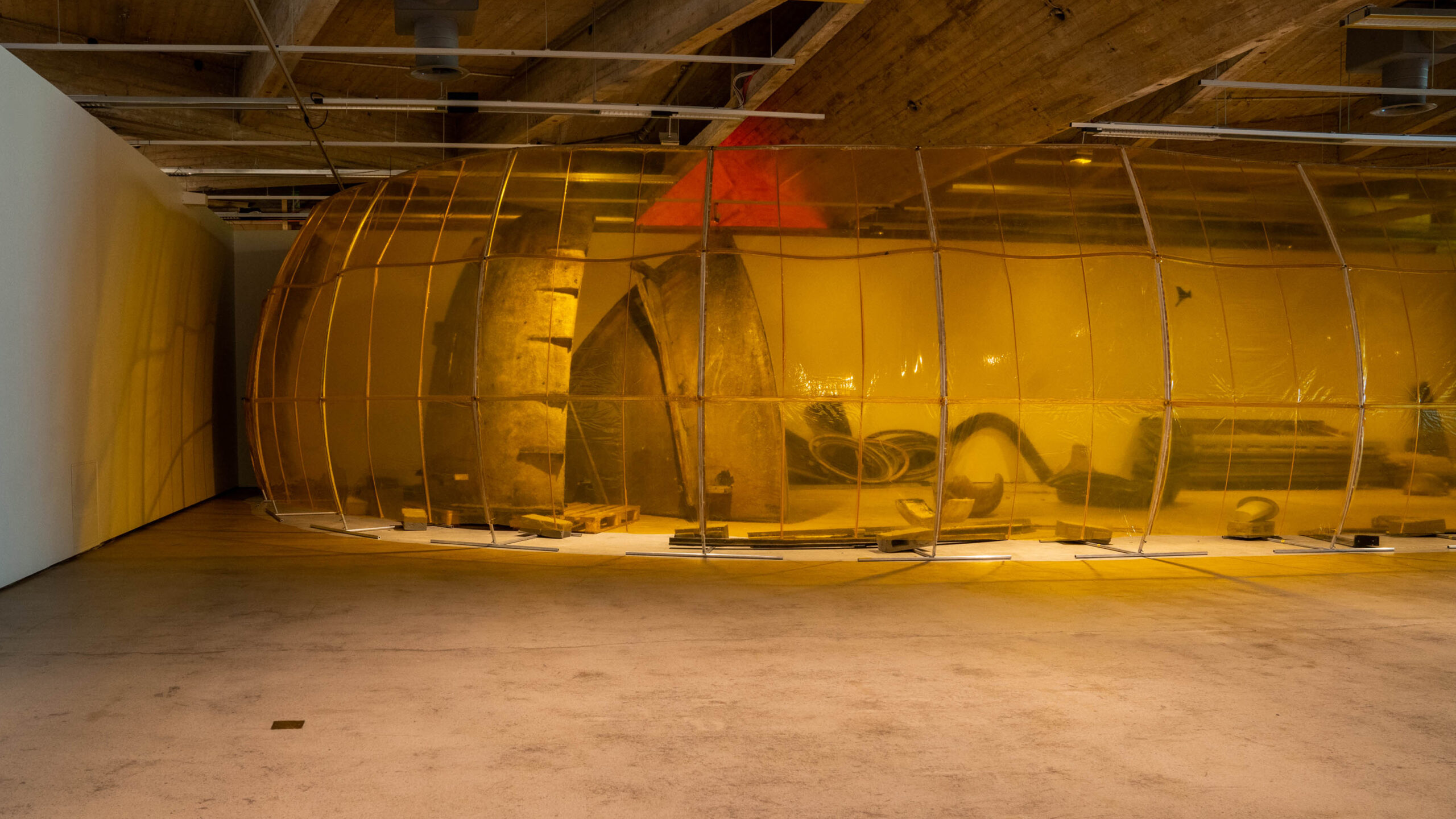
A solitary animatronic bird flies within a yellow space in a landscape comprising materials used for the construction of the WeeGee building and the nearby Futuro House, a 1968 work of space-age architecture, designed by Matti Suuronen. The flight path of the animatronic bird is based on the score of Violin Concerto No. 2 by the composer Magnus Lindberg.
The title of the piece, The Preserving Machine, is the namesake of a 1953 science fiction short story by Philip K. Dick about an attempt to preserve classical music in times of war and cultural collapse. In the narrative, a new piece of technology is invented that can encode musical scores into bodies of living animals, which are able to defend themselves once let into the world. However, these encrypted hybrids evolve and the music becomes unidentifiable as nature and culture compete for existence. The artist Dora Budor (b. 1984) uses the exhibition itself as her medium, wherein the characteristics of given context are amplified, dislodged or re-circuited. Budor uses site-specific materials, producing cinematic scenes that act as conduits of memory and meaning.
Film, robots, sci-fi, nature, culture
Tinted vinyl enclosure, biomimetic robot bird, custom audio-to-motion computer navigation system, site-specific architectural components: original casting molds of Futuro House (1968), bricks from the renovation of the WeeGee building (2006)
Lender of Futuro’s moulds: Ekin Muovi
Saastamoinen Foundation Art Collection
5. Sondra Perry
ffffffffffffoooooooooooouuuuuuuuuuurrrrrrrrrrrrrrrrrrrrrrrrrrr

Comprised of gym equipment and video monitors, Sondra Perry’s (b. 1986) sculpture invites visitors to sit one at a time on the structure to experience its video component, which stretches accross all four screens. An integral aspect of ffffffffffffoooooooooooouuuuuuuuuuurrrrrrrrrrrrrrrrrrrrrrrrrrrr is its almost hysterical soundscape, which includes the artist’s laughter, material from Disney animations and the music and lyrics of the musical Dreamgirls.
Perry often uses her own image as a basis for her work, at times distorted and stretched. Her practice explores identity, representation, the Black American experience, and various technologies.
Identity, technology, body
Video and bicycle workstation with four monitors
Duration 9:56 min
Saastamoinen Foundation Art Collection
6. Refik Anadol
Machine Hallucinations: Nature Dreams
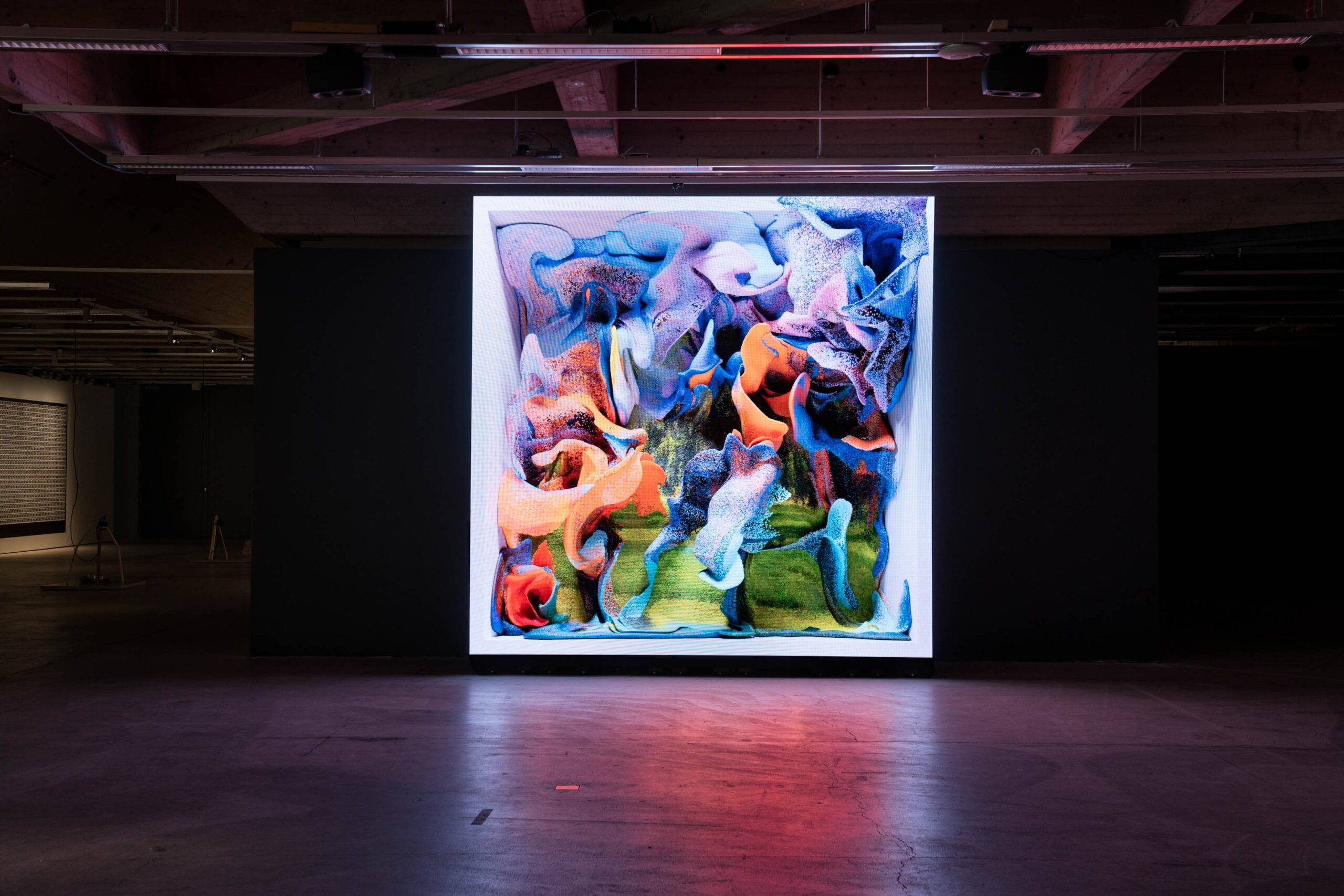
Machine Hallucinations: Nature Dreams emerges from Refik Anadol Studio’s long-term research project at the intersection of architecture, AI-based digital art and environmental studies. The artwork is an AI Data Sculpture that draws upon a dataset of more than 90 million publicly available nature-related images. This vast dataset is processed through custom software developed by Refik Anadol Studio to speculate alternative modalities of our relationship with nature.
Refik Anadol (b. 1985) is a media artist, director and pioneer in the aesthetics of data and machine intelligence. His body of work locates creativity at the intersection of humans and machines. Anadol takes data as the primary material and the neural network of a computerised mind as a collaborator. His art encourages us to rethink our engagement with the physical world, its temporal and spatial dimensions, and the creative potential of machines.
Artificial intelligence, machine learning, nature, culture, neural networks.
AI Data Sculpture, square format LED screen
Duration 20:00 min
Courtesy of the artist
7. and 15. Rafael Lozano-Hemmer
7. Pulse Index

Rafael Lozano-Hemmer’s (b. 1967) Pulse Index is an interactive work that displays the fingerprints of exhibition visitors together with their heart beats in a projected mosaic. While having their pulse detected by the artwork, the fingerprint of the participant is amplified 220 times by a microscope and projected on the wall. When the sensor is released the fingerprint and pulse that was detected is added to the database of previous recordings, pushing them one position down the array and erasing the oldest one.
In Lozano-Hemmer’s art, technology is a method to measure and enhance our perception and experience not only of biological processes but also of broad social phenomena such as control mechanisms. His works model various vital functions, such as the beating of the heart. They create platforms for collective experiences but also serve as catalysts for perceptive social analysis.
The fingerprints are not stored, instead, they eventually vanish as more fingerprints appear on the wall.
Biometric art, fingerprint, monitoring
Projector, computer, digital microscope, industrial camera, metal enclosure, custom software
Courtesy of the artist
15. Last Breath
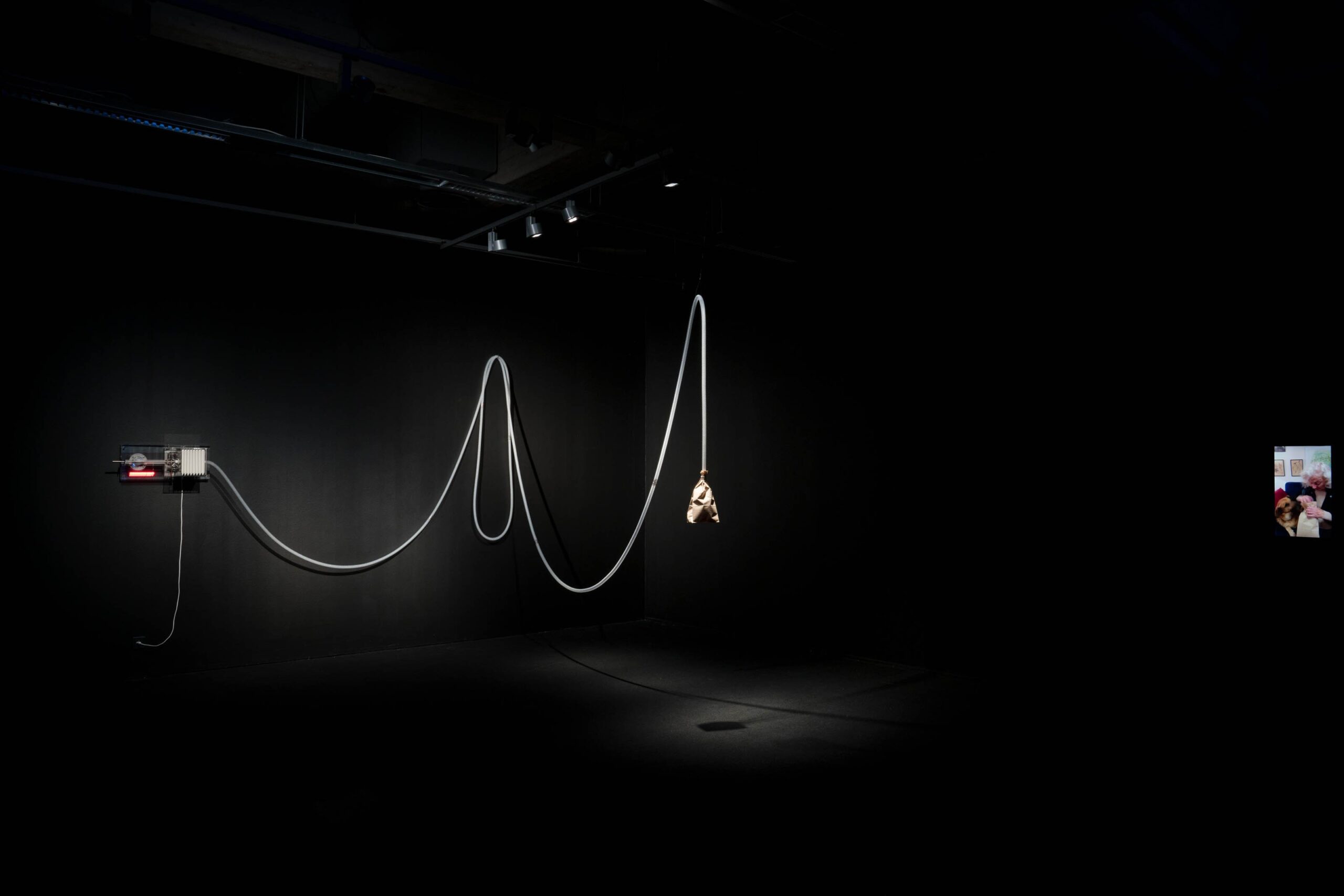
Lozano-Hemmer’s work stores and recycles a person’s breath forever. The paper bag in Last Breath empties and fills repeatedly thousands of times each day at the typical respiratory frequency of an adult at rest, representing breathing through both sound and motion. At EMMA, the work stores the breath of the actress Seela Sella. According to Lozano-Hemmer, Last Breath is a biometric portrait and also a romantic attempt to capture the passing presence of a person in the form of an artwork.
The work has previously been carried out at four different museums with four distinguished singers, poets and composers whose breath plays an important role in their own art. They are the Cuban musician and singer Omara Portuondo, the American composer and accordionist Pauline Oliveros, the Ecuadorian poet Efrain Jara, and the Canadian poet and activist Nicole Brossard.
Biometric art, death, continuity, design
Breath: Seela Sella
Motor, bellows, plexiglass, digital display, custom circuitry, Arduino processor, respiration tubing, brown paper bags
EMMA – Espoo Museum of Modern Art Collection
Artist Interview

8. Raimo Saarinen
A Cross-Section of an Imaginary Slope

Raimo Saarinen (b. 1984) creates live sculptures from plants and soil. Saarinen has brought natural elements into EMMA which, on closer inspection, have been made and maintained by humans. His work asks how much of our surroundings are made and shaped by humans. What structures are hidden in the landscape?
Saarinen feels the word ‘nature’ is problematic because it means different things to different people. He challenges us to think about our relationship with our natural surroundings and how nature is often understood as something separate from humans, as a resource to be controlled. Maybe in the future people in the West can see their own activity as a small part of nature?
Nature, relation to nature, utilisation
Laminated veneer lumber, softwood plywood, single-component moisture barrier,stones, roots, storm water pipe, electrical conduit, metal netting, red clay, pape, flax fibre, pigment, sand, soil, plants
Courtesy of the artist
9.-10. Anna Ridler
9. Mosaic Virus and 10. Myriad (Tulips)

Anna Ridler (b. 1985) is an artist and researcher working on various systems of knowledge. She is particularly interested in studying how technology can help us understand the world around us. The installation Myriad (Tulips) features hundreds of photographs of Dutch tulips taken and hand-labelled by the artist. Ridler used the same photographs to create the database for Mosaic Virus. She wanted to make visible the human labour involved in compiling the database for the artificial intelligence used in the video work.
Mosaic Virus was inspired by the Dutch tulip mania of the 1630s. It is considered one of the first market bubbles. The title refers to a strain of virus that causes stripes in the petals of the flowers, as a result of which the price of tulip bulbs first soared then plunged. The changes that take place in the tulips in Mosaic Virus reflect the exchange rate for Bitcoin when the work was made. The artist sees many similarities between crypto currencies and the tulip mania.
Tulip mania, artificial intelligence, algorithms, knowledge systems, database, crypto currency
Mosaic Virus:
3-screen GAN video installation
Duration 30:00 min
Courtesy of the artist
Myriad (Tulips):
C-type digital prints with handwritten annotations, magnetic paint, magnets
Courtesy of the artist

Artist Interview
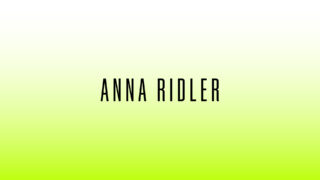
11.-12. Stephanie Dinkins
11. Not the Only One

Stephanie Dinkins (b. 1964) wants to spark dialogue on race, gender and ageing. She uses a variety of technologies in her works and is particularly interested in creating a more equal technological future. Not the Only One is an interactive glass sculpture with which the audience can communicate by speaking and listening.
The artist used artificial intelligence in the sculpture, feeding it information about the life of a Black American family over several generations. The artificial intelligence was designed, trained and adapted to the perspectives of Black people, who are underrepresented in the technology sector. Over time, discussions with the audience influence its story-telling skills by increasing and improving the database available for interaction. The artist considers the work quirky because the entity is not always communicative and conversations do not always proceed as you would expect.
Artificial intelligence, database, unequal algorithms, family histories
12. Conversations with Bina48: Fragments 7, 6, 5, 2

Conversions with Bina48 is a continuous artistic project comprising a series of video interviews between Dinkins and the first black social robot. The robot – Bina48 – is working toward independent thought and emotion. The artist’s goal is to make friends with the robot and get it to answer the question “Who are your people?”
So far, the artist and the robot have discussed family, racism and the civil rights of robots, and consciousness, loneliness and Bina48’s concerns about her robot friends. Their discussions have been surprisingly humorous, philosophical and sometimes nonsensical. Some conversations have been frustrating for both the artist and robot alike.
Social robot, friendship, identity
Digital video on monitors
Duration 12:00 min
Courtesy of the artist
Artist Interview

13. Teemu Lehmusruusu
Parent Matter

Teemu Lehmusruusu uses his work to study the conditions necessary for the existence of ecosystems and food chains. In the installation Parent Matter, 3D-animations of soil generation are combined with natural materials formed by humans and geological forces. The work examines the invisible world of our planet’s soil, which enables life on Earth. Using artistic methods, Lehmusruusu makes visible that which usually remains hidden to our senses, such as the capacity of mycelia to effect change, the breathing of plants and the subtle processes of soil.
The piece challenges us to think about what we miss because of our limited senses and how this impacts our actions. The title refers to the geological term ‘parent material’, which means an internal source, such as bedrock and sedimentary rock, which determines the composition of soil. According to the artist, we should see soil as our parent and as the source of our nourishment.
Soil, geological forces, nature, food chain, technology
Wood, blown glas, clay, stone, tripod, projection
EMMA – Espoo Museum of Modern Art Collection
Artist Interview

14. Heather Dewey-Hagborg
Stranger Visions

Heather Dewey-Hagborg (b. 1982) is an artist, researcher and biohacker interested in using scientific research and technological critique in her art. For Stranger Visions, Dewey-Hagborg collected various items, such as hair and cigarette stubs found in the streets and other public spaces of New York City. Using DNA extracted from this material, she created 3D-printed sculpture portraits.
The work draws attention to phenotyping, a DNA method used in some countries in criminal investigation. Although facial images made on the basis of DNA are not accurate, it is possible with phenotyping to guess the probable colour of a person’s skin, eyes or hair or the shape of their nose. Dewey-Hagborg believes the method is too inaccurate and biased for criminal investigation. There is also a risk that it could be used in biological surveillance.
Biohacker, DNA, phenotype, biological monitoring
Found genetic materials, custom software, 3d prints, documentation
and Video documentation: duration 4:17 min
Fridman Gallery
Artist Interview

16. Lu Yang
Lu Yang Delusional Mandala

The video follows the ritualistic journey of Lu Yang’s genderless 3D avatar from birth to death. The avatar undergoes a number of physical and mental changes by expressing itself through dance, as if trying to transcend normal consciousness through movement. The avatar’s head is surrounded by a stereotactic frame used to stimulate and manipulate the brain and which eventually transforms into a halo. Eventually, the figure dies and ends up in a coffin that is taken away in a vehicle resembling a psychedelic temple.
Lu Yang has drawn inspiration from the images of Tibetan Buddhism and video games. The work is a fusion of different religions, neurosciences and science fiction and examines the boundaries of human consciousness and the mind. At the same time, it illustrates a digital human who can choose an identity from a wide range of options.
Science fiction, neuroscience, consciousness, rituals, identity, body, avatar
Video
Duration 16:27 min
Courtesy of the artist
17. Sougwen Chung
Assembly Lines

Sougwen Chung is a Chinese-Canadian artist and researcher, and the founder and artistic director of Scilicet, a London-based studio exploring human & non-human collaboration.
Through painting and live performances, Chung co-creates with machines named D.O.U.G. (Drawing Operations Unit: Generation 1−5), a multi-generational family of drawing robots.
In the work created for EMMA, Chung built a large-scale kinetic installation featuring Drawing Operations Unit: Generation 5 (D.O.U.G. 5). Activated through live performance, this generation makes use of a stream of human brain activity recorded from the artist’s daily meditation practice. Chung created the paintings that are on view as part of the installation, during a collaborative performance with the robots at the opening of the exhibition.
The resulting paintings form part of the Assembly Lines installation, created during the performance between Chung and the robotics at the opening of the exhibition. Accompanying short film Assembly Lines: Expanse [extending], can be viewed within the exhibition space.
Production of the work was supported by the Saastamoinen Foundation and Studio Scilicet.
Robotics, drawing with a machine, performance
Installation (painting, robotics, A.I., performance)
and Perfomance Film.
Courtesy of the artist
Artist Interview

18.-20. Agnieszka Kurant
18. Post-Fordite no. 6, Post-Fordite no. 7 and Post-Fordite no. 8

Agnieszka Kurant (b. 1978) has made Post-Fordites from a quasi-geological formation: fossilised automotive paint buildup – known as Fordite, or Detroit agate – that, over years of spray-painting of cars at factories, congealed into stones with geological patterns. After car production was automated and outsourced overseas and to the suburbs, the workers of now defunct plants discovered Fordite, which can be cut, polished and used to produce jewelry, and therefore becomes rare and valuable.
Kurant buys fragments of Fordite from factories and combines them into speculative rock formations. Fordite can be described as a modern fossil that reflects the impact of human activity. This series of works is part of an artistic analysis carried out by Kurant in which she examines how value is created in a capitalist system and how the concept of work is changing.
Fossil, geology, capitalism, market bubble
Fossilized enamel paint, epoxy resin, iron, powdered stone
Courtesy of the artist and Tanya Bonakdar Gallery
19. Air Rights 7

Agnieszka Kurant’s work Air Rights 7 deals with the characteristics of economic mechanisms. The levitating stone, akin to a meteorite, is like a stock or real estate market bubble that looks stable but in reality is very fragile and may burst with serious consequences. The market of air rights in major cities around the world, based on the empty space above a property, is created out of ‘thin air’. At the same time, future mining of asteroids in outer space has become an object of speculation.
Capitalism, market bubble
Powdered stone, foam, wood, electromagnets, custom pedestal
Courtesy of the artist and Tanya Bonakdar Gallery
20. Chemical Garden (2021)

Kurant’s Chemical Garden consists of complex crystalline structures resembling plants, created by mixing inorganic chemicals – metal salts, which are ingredients in modern computers – with sodium silicate. Billions of years ago chemical gardens emerging on the sea floor from metals such as used in Kurant’s installation are likely to have had an important role in the emergence of life. On the other hand, today, digitalisation requires industrial extraction of the same metals, which disrupts the environment and entire ecosystems.
Although created from lifeless minerals, the plant forms react to micro-vibrations in the environment. As a result, the work changes over time. Kurant investigates the relationship between the digital, biological and mineral, exploring how organic and inorganic substances in the world are continually reorganised into various unstable forms.
In co-operation with Dr. Magdalena Osial, Warsaw University.
Minerals, chemicals, origin of life, digitalisation, environmental threats
Sodium silicate, copper, nickel, cobalt, chromium, manganese, iron and zinc salts, glass aquarium
Courtesy of the artist and Tanya Bonakdar Gallery
Artist Interview

21. Jakob Kudsk Steensen
RE-ANIMATED

Jakob Kudsk Steensen’s (born 1987) work consists of narrative videos, an audio scape, a physical installation and a section viewed through a VR headset. The work was inspired by the mating call of the Kaua’i ‘ō‘ō bird, which the artist discovered on YouTube. The bird was once found on the Hawaiian island of Kaua’i. It probably became extinct in 1987 as a result of human activity that made its habitat unsuitable.
Like a digital gardener, Jakob Kudsk Steensen has collected and planted an immense amount of vegetation with algorithms to revive the bird and its original habitat. At the same time, he examines the irreversible impact of human activity on nature. While the artist uses virtual reality in his work, his aim is to make technology invisible and to use it to enhance the bodily experience of the work’s content. For the artist, virtual reality is also an effective way to slow down time.
Algorithms, virtual reality, digital gardening, endangered species
Videos:
Arrival 10.30 min
Mating Call 3.25 min
Bug Zapper 5.45 min
Special thanks to the The American Museum of Natural History, NYC
for granting access to the Ornithology Archive, and Cornell Lab of Ornithology and the Macaulay Library.
RE-ANIMATED is made with support from The Danish Arts Foundation, Bikuben Foundation, Harvestworks, Mana Contemporary and Artist Alliance
Artist, producer and main developer: Jakob Kudsk Steensen
Composer and Music Director: Michael Riesman
Co-producer: Toke Lykkeberg Nielsen and Tranen Contemporary Art Center
Music technical director and audio programmer: Jerry Smith
Character optimization: Jeremy Thompson, 2Nstudio
Programming assistance and audio interactivity: Todd Bryant, 2Nstudio
Narration: Michael Silberblatt
Interview and research consultant: Douglas H. Pratt
Bird song visualization: Andy Thomas
Research assistant: Jazia Hammoudi
VR and video installation
Courtesy of the artist
Artist Interview

22. Brandon Lipchik

Brandon Lipchik (b. 1993) first sketches his subjects on a computer in a 3D world and then paints them on a canvas by hand. The paintings show the subjects simultaneously from several different perspectives. They are somehow reminiscent of the aesthetic of computer animations and music videos from the early 1980s but on the other hand, they recall the tradition of Californian painting, full of light and colour.
The subjects of the paintings are set in the visual world of the American dream, among neat suburban lawns and swimming pools. The figures in the paintings, assumed to be male, play together, tend to their gardens or laze in the pool, admiring their own reflections or taking pictures of each other. In fact, the swimming pools in Lipchik’s paintings are intimate venues for self-reflection, and the narratives that form around them examine class, identity, sexuality and ecology.
Identity, body, digital, sexuality
Hot Tub Watch
2021
Oil and acrylic paint on canvas
Private Collection
Elizabeth Taylor’s Reflection
2021
Oil and acrylic paint on canvas
Private Collection
Repotting Plants Outgrown
2020
Oil and acrylic paint on canvas
Private Collection
Gardener
2019
Oil and acrylic paint on canvas
Miettinen Collection, Berlin – Helsinki
Dropping Swords in Paths Untrodden
2020
Oil and acrylic paint on canvas
Miettinen Collection, Berlin – Helsinki
Pool Shoot
2021
Oil and acrylic paint on canvas
X Museum, Beijin
Rainshower
2021
Oil and acrylic paint on canvas
X Museum, Beijing
Artist Interview

Love Simulation EVE: Water Spirits

Dive into a virtual world and awaken the water spirit inside you. Share a moment with a friend or stranger and let joy flow! Water Spirits is an interactive encounter between two people in a virtual aquatic world. Put on a VR set and dive into the eternal sea.
Love simulation EVE: Water Spirits is a virtual reality piece by Eero Tiainen and the EVE team on the power of encounters between people. In the EVE team AI researchers and metaverse artists develop love algorithms in a world of virtual reality and artificial intelligence. EVE has been in development already since 2017 in collaboration with Aalto University among others. In March 2023, Team EVE will offer full-evening long Love Simulation EVE at the Espoo City Theatre.
Water Spirits can be experienced on Fridays from 17 to 19 o’clock, on Saturdays from 13 to 16 o’clock and on Sundays from 13 to 16 o’clock. It is approximately 5 minutes long. You can sign up with the staff when you arrive. The experience is suitable for over 7-year-olds. At other times you are welcome to relax in the soft Lap-chairs in the room.
Artistic Director: Eero Tiainen
Producer: Inna Huttunen
VR Designer: Iikkamatti Hauru
Programmers: Mikko Honkanen, Rongzhi Liu, Michael Jelbart
AI Developer: Evelin Jalonen
Assistant VR Developer: Maciej Tomaszewski
Sound Designers: Iikkamatti Hauru, Matias Harju
Intimacy Director: Juuso-Matias Maijanen
Production: Avatar’s Journey ja Espoon Kaupunginteatteri
Partners: Helsinki XR Center, MAGICS infrastructure, Aalto University, the Finnish Cultural Foundation, Arts Promotion Centre Finland
Lap-chair design and production: Maria Jännes, Maria Vähäsarja
Vocabulary
Algorithm
A detailed description or instructions created by humans to perform a task. For example, a set of commands that a computer executes in a specified order. Algorithms can be extremely complex and contain millions of rows of instructions.
Artificial intelligence
Artificial intelligence (AI) is a piece of software that is capable of performing tasks in complex environments without continuous intervention and that can improve its performance independently.
Avatar
A character that represents a person in a virtual world such as a computer game.
Biohacker
A person who wants to promote their health and performance by using technical tools to make various measurements of themselves. For example, biohackers collect information on their diet and sleep, and have their inflammation or vitamin levels checked or their genetic ancestry analysed.
Biometrics
A technical and scientific field in which identification methods based on human physiology are developed, including fingerprint recognition.
Cryptocurrency
Digital currencies based on cryptography techniques. There are currently thousands of cryptocurrencies.
DNA
Abbreviation of deoxyribonucleic acid. A molecule that contains the genetic material of the cells of all organisms and certain viruses. When an organism reproduces, this material is copied and passed on to the offspring.
GAN
Abbreviation of Generative Adversarial Network. GANs consist of artificial neural networks that contest each other. A GAN is a machine learning algorithm that uses a training set to generate images alike those in the set without directly copying them. In the GAN, another neural network acts as a critic to the generating network to guide it toward making better images without human intervention.
Information system
A system consisting of data, humans processing the data, data processing and transmission equipment, software and data processing rules. A more complex and varied concept than computer software.
Machine learning
A field of artificial intelligence and a wide family of algorithms in which the aim is to train a computer to perform complex tasks of deduction through using examples. For example, it is extremely difficult to create an algorithm that can recognise a cat in an image. Machine learning methods offer a work-around to this problem: they train algorithms with images of cats and non-cats to teach them to tell the difference.
Metaverse
A network consisting of multiple virtual 3D worlds that enable social interaction.
Neural network
A machine learning algorithm that loosely mimics the functioning of the brains of humans and other animals using computational nerve cells or neurons that are linked to each other and enable complex problems to be solved.
Neuroscience
A scientific field that studies the structure and functions of the nervous system. A multidisciplinary field that includes cognitive psychology, information science, statistics and medicine.
Phenotype
A phenotype is the set of observable characteristics or traits of an individual organism. It is an outcome of genetic and environmental factors.
Social robotics
A field of robotics that develops robots which interact with users.
Virtual reality
Virtual reality (VR) created through sensations generated by computer simulation. A virtual reality can be based on a real or an imaginary world. In addition to visual material, other sensory stimuli such as simulated audio or motion stimuli based on the sense of touch can also be used.
